Mikroelektronika d.o.o.
Carte Click ETH à deux fils
Carte Click ETH à deux fils
Impossible de charger la disponibilité du service de retrait
Key Features
- Ethernet PHY 10BASE-T1S hautes performances, interface périphérique série standard de l'industrie, transfert simultané des paquets de transmission et de réception, interruption d'état, deux cavaliers pour activer la terminaison de bord 100Ω, fonction de réveil, EEPROM d'adresse MAC, réinitialisation, et plus encore
- Basé sur le LAN8651 - Contrôleur Ethernet MAC-PHY 10BASE-T1S à port unique avec SPI de Microchip
- Peut être utilisé pour le contrôle industriel, l'automatisation des processus/usines, les réseaux de capteurs/actionneurs fonctionnant à large bande passante, l'automatisation des bâtiments, etc.
- mikroBUS : interfaces I2C, SPI et GPIO
Présentation de la carte Click Board™ ETH à deux fils : votre solution pour une connectivité Ethernet à faible coût
La carte Click Board™ ETH à deux fils est la carte complémentaire compacte dont vous avez besoin pour créer une interface générique vers de nombreux processeurs tiers dans les applications 10BASE-T1S. Avec le LAN8651, un contrôleur Ethernet MAC-PHY 10BASE-T1S à port unique à faible consommation avec SPI de Microchip, vous pouvez désormais accéder facilement aux réseaux 10BASE-T1S.
Combinant un contrôleur d'accès au support (MAC) et un PHY Ethernet, le LAN8651 permet aux microcontrôleurs à faible coût d'accéder aux réseaux 10BASE-T1S, ce qui permet de créer des topologies de réseau multipoints et point à point. Grâce au transfert simultané des paquets de transmission et de réception Ethernet entre le contrôleur de station et le LAN8651 via une interface périphérique série (SPI) à haut débit, conformément à la spécification d'interface série MAC-PHY 10BASE-T1x d'OPEN Alliance, vous pouvez être sûr que le transfert de données est à la fois rapide et fiable.
Mais ce n'est pas tout : la carte Two-Wire ETH Click Board™ convient à une large gamme d'applications liées à la sécurité fonctionnelle, notamment le contrôle industriel, l'automatisation des processus/usines, les réseaux de capteurs/actionneurs fonctionnant à large bande passante, l'automatisation des bâtiments, etc.
Développement de logiciels simplifié avec mikroSDK
La carte Click Board™ Two-Wire ETH est prise en charge par une bibliothèque compatible mikroSDK, qui comprend des fonctions qui simplifient le développement logiciel. Avec cette carte Click Board™, vous pouvez économiser un temps et des ressources précieux tout en garantissant que votre projet est opérationnel le plus rapidement possible.
De plus, la carte Two-Wire ETH Click Board™ est un produit entièrement testé, prêt à être utilisé sur un système équipé de la prise mikroBUS™. Alors pourquoi attendre ? Commandez votre carte Two-Wire ETH Click Board™ dès aujourd'hui et commencez à profiter d'une connectivité Ethernet fiable et à faible coût !
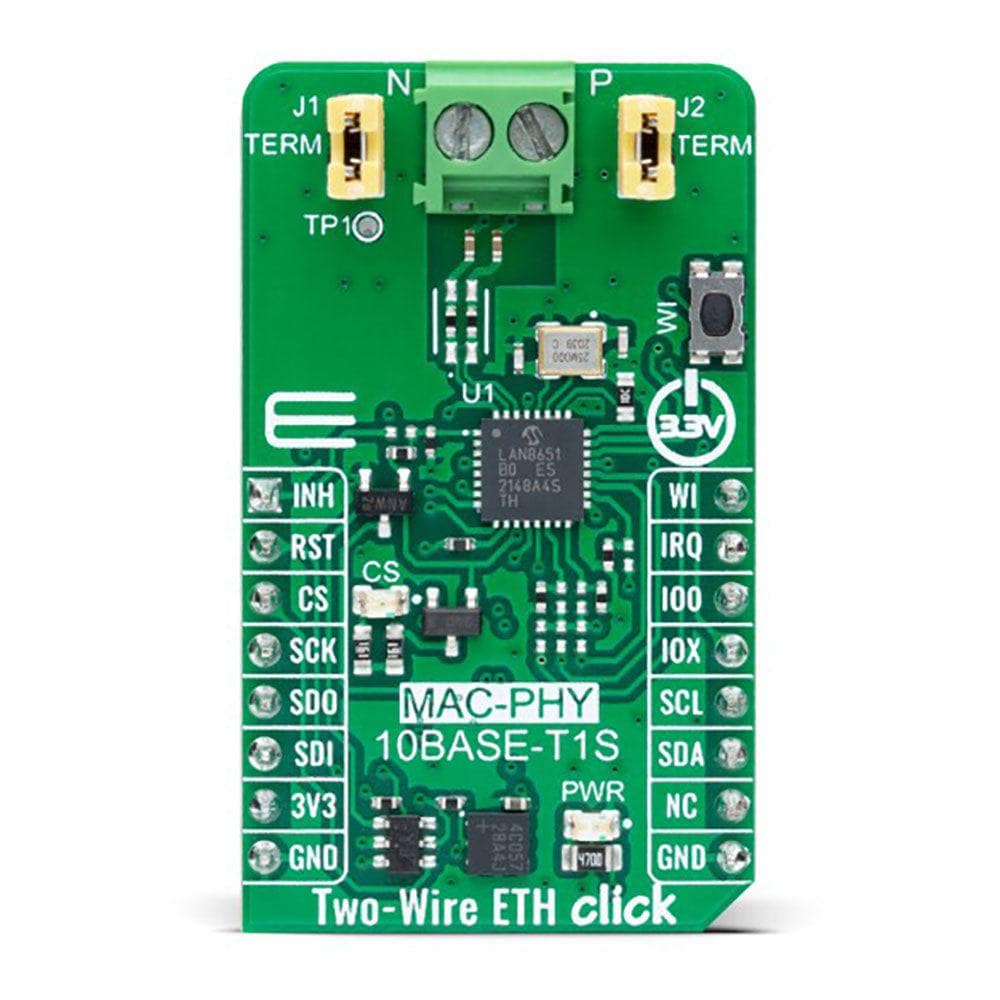
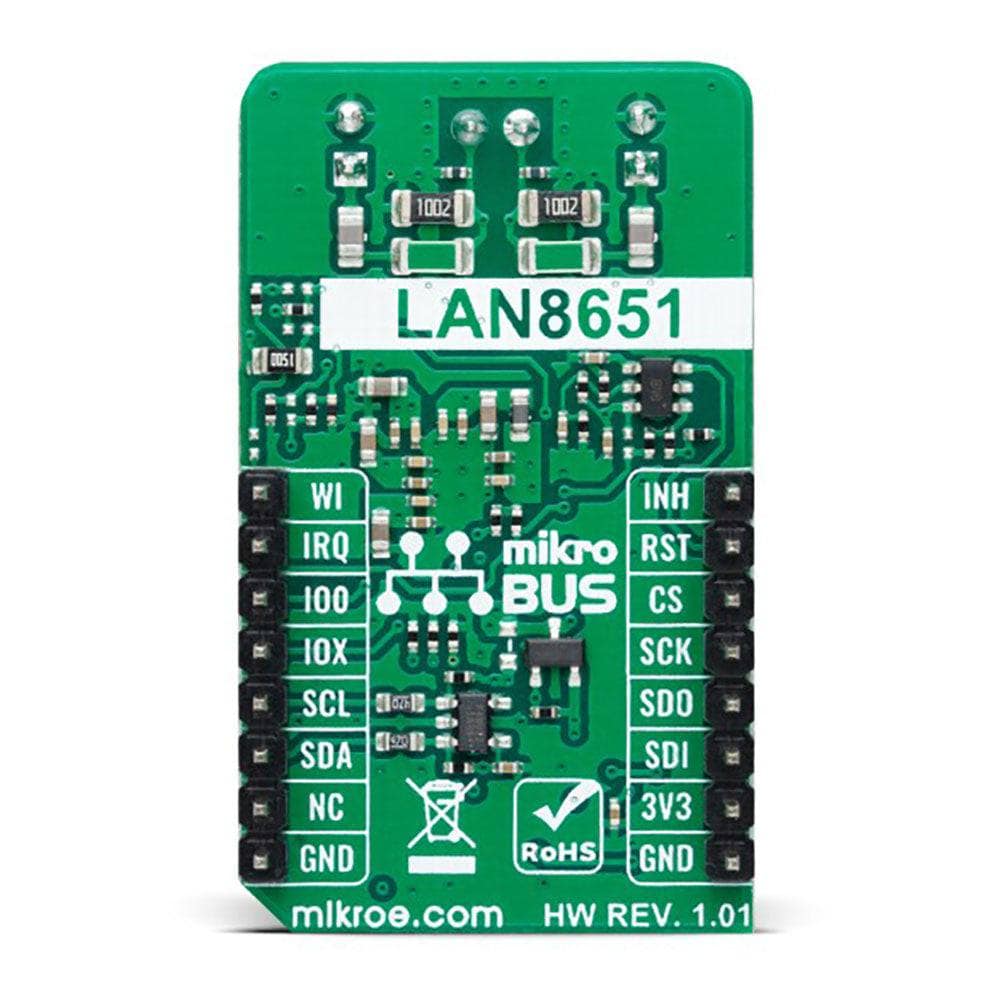
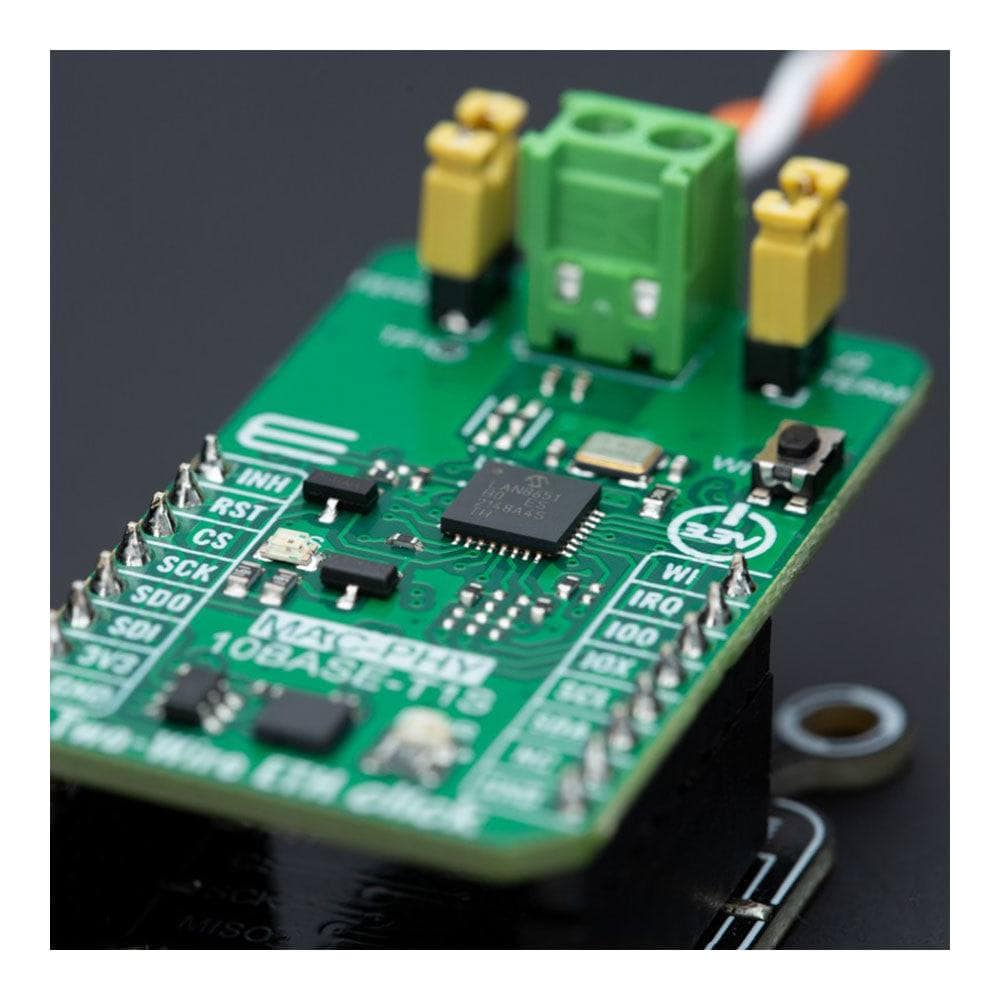
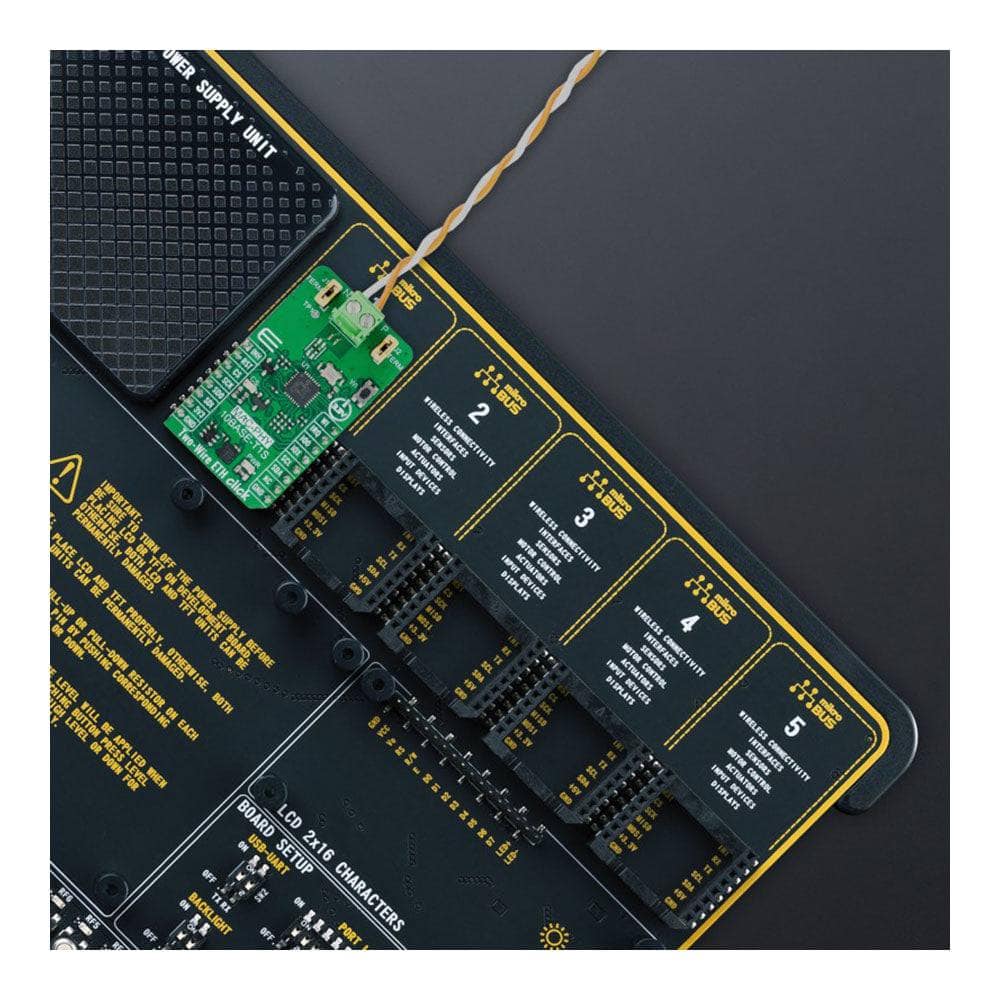
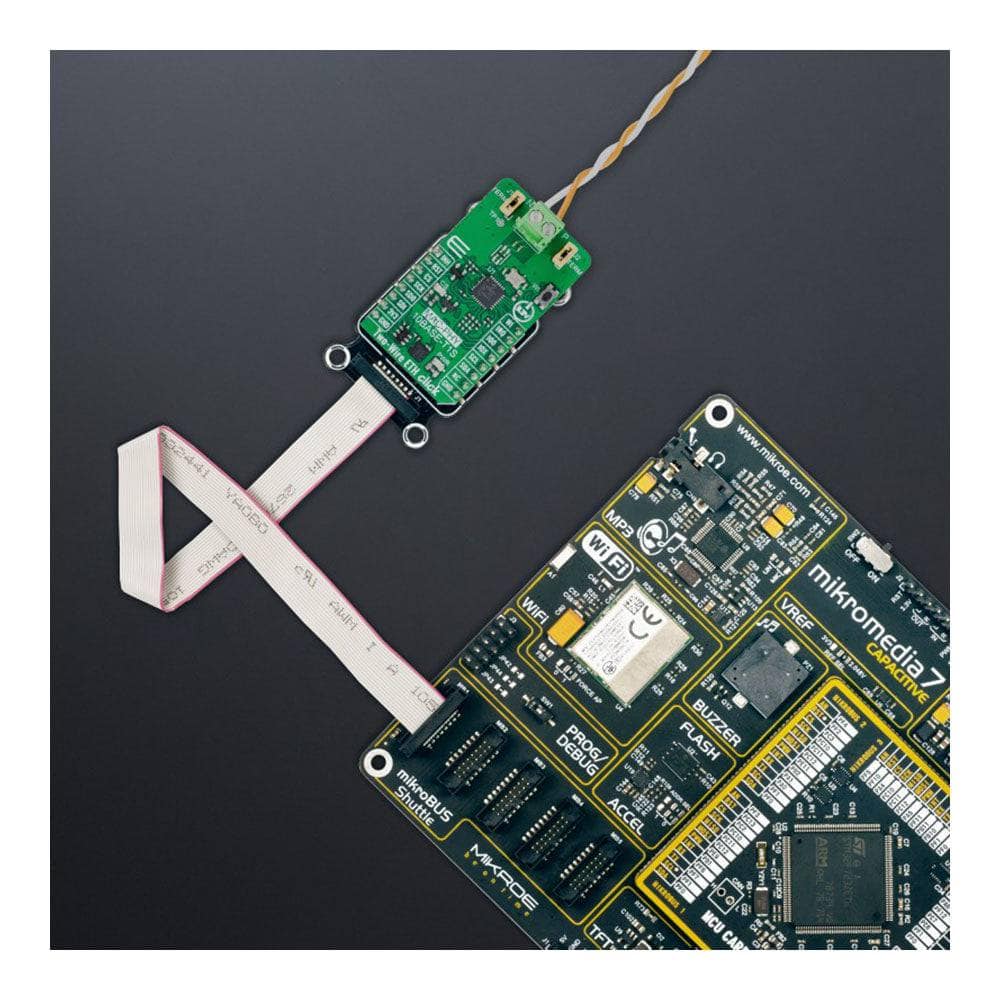
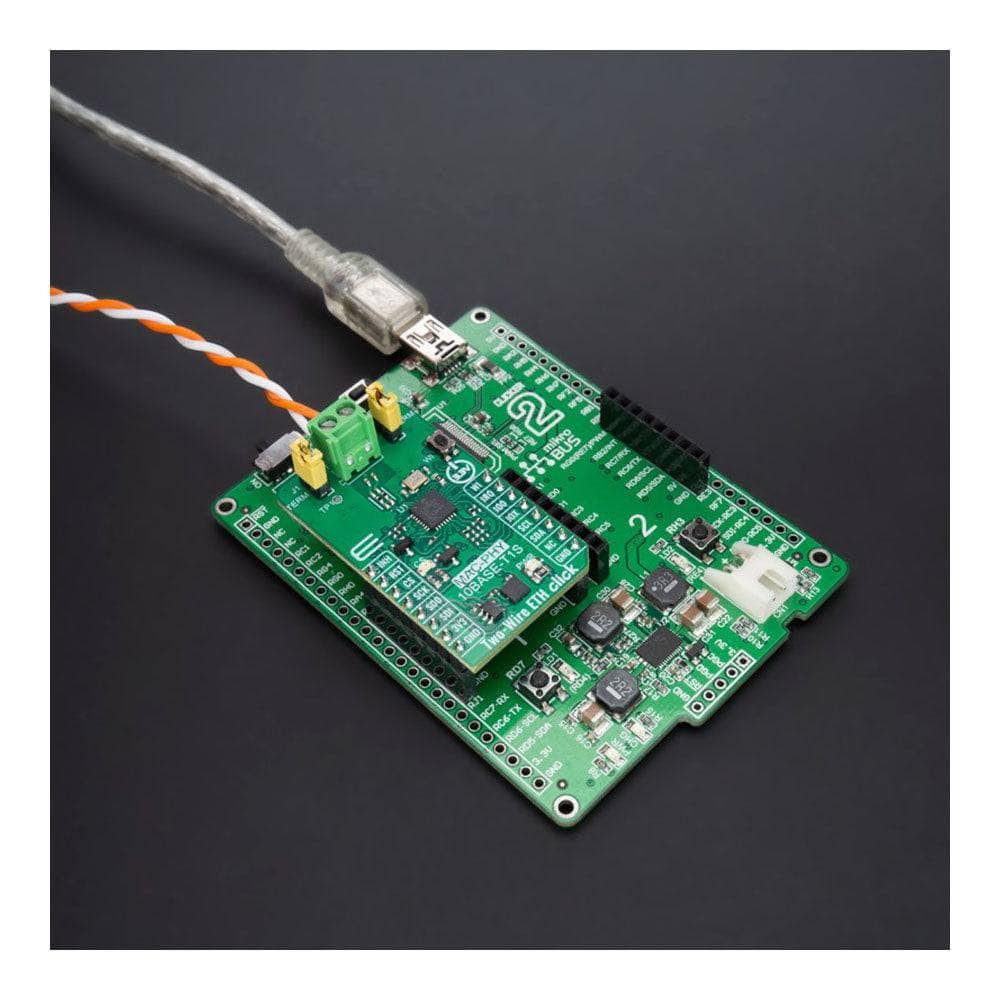
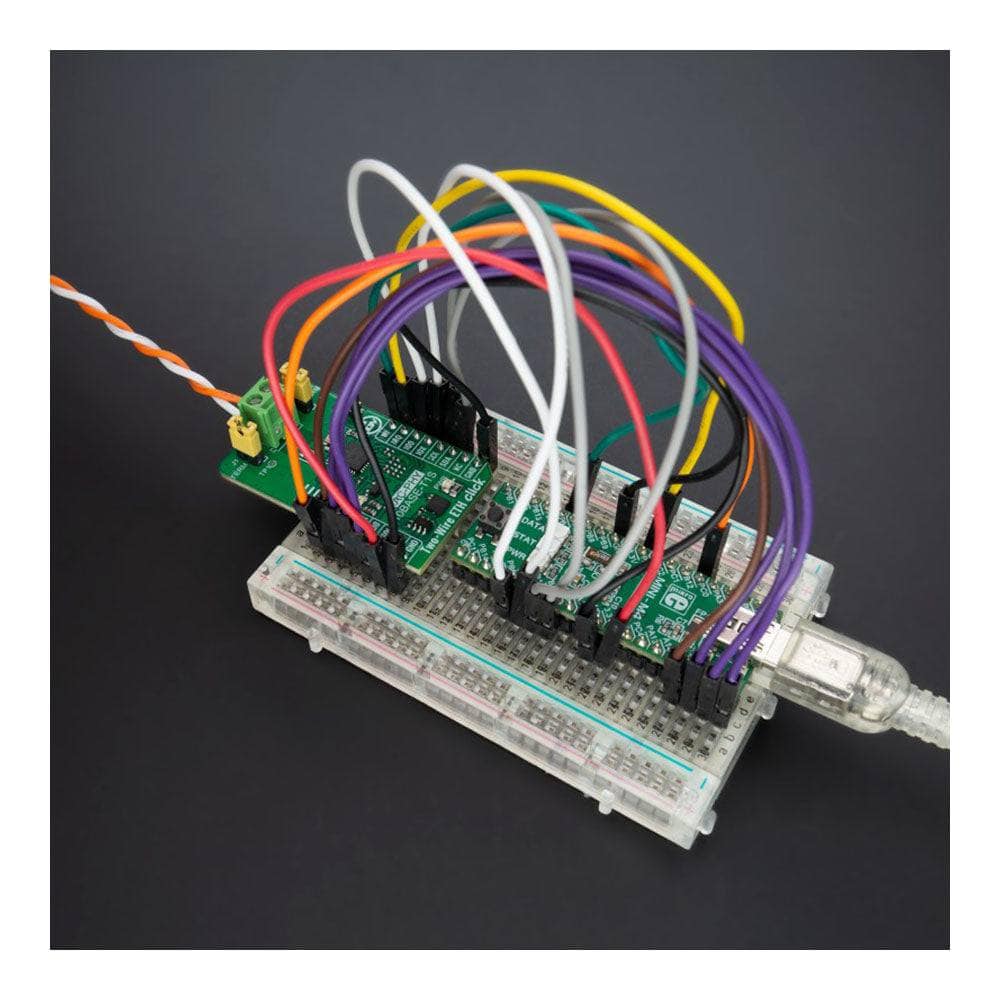
How Does The Two-Wire ETH Click Board™ Work?
The Two-Wire ETH Click Board™ is based on the LAN8651, a compact, low-power, single-port 10BASE-T1S MAC-PHY Ethernet Controller with SPI from Microchip designed according to the IEEE Std 802.3cg-2019 and OPEN Alliance TC-6 10BASE-T1x MAC-PHY Serial Interface specifications. The LAN8651 combines a Media Access Controller (MAC) and PHY to enable low-cost MCUs to access 10BASE-T1S networks. It provides 10Mbit/s half-duplex transmit and receive capability over a single balanced pair of conductors connected to the onboard Ethernet terminal. The LAN8651 also complies with industrial EMC and EMI requirements, making it suitable for functional safety-related applications.
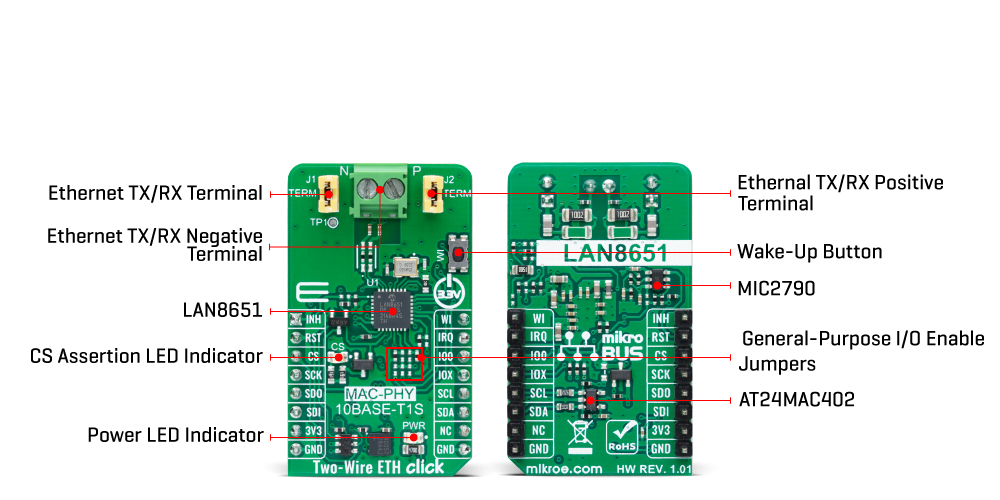
The integrated PHY of the LAN8651 allows for creating both multidrop and point-to-point network topologies, with up to at least 15m in length for a point-to-point network. The multidrop mode supports up to at least 8 PHYs connected to a common mixing segment of up to at least 25m in length. The ability to connect multiple PHYs to a common mixing segment reduces weight and implementation costs by reducing cabling and switch ports.
The LAN8651 integrated Ethernet MAC communicates with the host MCU through a standard Serial Peripheral Interface (SPI) supporting high clock speed up to 25MHz. Ethernet data transfer as well as command/status commands are performed over a single, serial interface. The serial interface allows of both transmit and receive packets simultaneously between the station controller and the LAN8651. Packets are typically stored within the LAN8651 before being forwarded to either the station MCU or the network. Alternatively, packets may be transferred in a cut-through mode, with minimal buffering, for applications needing reduced latency. In addition to the Ethernet terminal mentioned above, this board has two jumper settings for enabling 100Ω edge termination at the ends of a 10BASE-T1S segment. Both jumpers must be populated to allow edge termination.
Alongside SPI pins of the mikroBUS™ socket, this Click board™ also has a multi-function interrupt IRQ pin, GPIO interface on IO0 and IOX, and a general reset signal to reset the LAN8651. In addition to hardware reset, the possibility of a Power-On reset is also provided, achieved using the MIC2790. It also has a Wake-Up function, accomplished by the WI pin or the WI button, and an additional INH indicator set to a low logic state in Sleep mode or a high state when PHY determines a qualified Wake-Up condition. To make identification as simple as possible, this board also has an additional EEPROM memory, the AT24MAC402, accessible via the I2C interface.
The Two-Wire ETH Click Board™ can only be operated with a 3.3V logic voltage level. The board must perform appropriate logic voltage level conversion before using MCUs with different logic levels. However, the Click board™ comes equipped with a library containing functions and an example code that can be used as a reference for further development.
SPECIFICATIONS
| Type | Ethernet |
| Applications | Can be used for industrial control, process/factory automation, sensor/actuator networks operating at high bandwidth, building automation, and more |
| On-board modules | LAN8651 - single-port 10BASE-T1S MAC-PHY Ethernet Controller with SPI from Microchip |
| Key Features | High-performance 10BASE-T1S Ethernet PHY, an industry-standard serial peripheral interface, simultaneous transfer of transmit and receive packets, status interrupt, two jumpers for enabling 100Ω edge termination, Wake-Up feature, MAC address EEPROM, reset, and more |
| Interface | GPIO,I2C,SPI |
| Compatibility | mikroBUS |
| Click board size | M (42.9 x 25.4 mm) |
| Input Voltage | 3.3V |
PINOUT DIAGRAM
This table shows how the pinout of the Two-Wire ETH Click Board™ corresponds to the pinout on the mikroBUS™ socket (the latter shown in the two middle columns).
| Notes | Pin |  |
Pin | Notes | |||
|---|---|---|---|---|---|---|---|
| Sleep/Wake Indicator | INH | 1 | AN | PWM | 16 | WI | Wake In |
| Reset | RST | 2 | RST | INT | 15 | IRQ | Interrupt |
| SPI Chip Select | CS | 3 | CS | RX | 14 | IO0 | General-Purpose I/O |
| SPI Clock | SCK | 4 | SCK | TX | 13 | IOX | General- Purpose I/O |
| SPI Data OUT | SDO | 5 | MISO | SCL | 12 | SCL | I2C Clock |
| SPI Data IN | SDI | 6 | MOSI | SDA | 11 | SDA | I2C Data |
| Power Supply | 3.3V | 7 | 3.3V | 5V | 10 | NC | |
| Ground | GND | 8 | GND | GND | 9 | GND | Ground |
ONBOARD SETTINGS AND INDICATORS
| Label | Name | Default | Description |
|---|---|---|---|
| LD1 | PWR | - | Power LED Indicator |
| LD2 | CS | - | CS Assertion LED Indicator |
| J1 | J1 TERM | Populated | 100Ω Edge Termination Jumper |
| J2 | J2 TERM | Populated | 100Ω Edge Termination Jumper |
| T2 | WI | - | Wake-Up Button |
TWO-WIRE ETH CLICK ELECTRICAL SPECIFICATIONS
| Description | Min | Typ | Max | Unit |
|---|---|---|---|---|
| Supply Voltage | - | 3.3 | - | V |
| PHY Speed | - | 10 | - | Mbit/s |
Software Support
MikroElektronika does not currently provide software support for the Two-Wire ETH Click Board™ in the form of libraries, functions, or example code. The software support is provided by our development partner on this project Microchip. Please visit the Microchips LAN8651 product page or Github repository to get protocol driver support for this IC.
Software Support
MikroElektronika does not currently provide software support for the Two-Wire ETH Click Board™ in the form of libraries, functions, or example code. The software support is provided by our development partner on this project Microchip. Please visit the Microchips LAN8651 product page or Github repository to get protocol driver support for this IC.
Carte Click ETH à deux fils
Frequently Asked Questions
Ask a Question-
Is the Two-Wire ETH Click Board™ tested before delivery?
Yes, the Two-Wire ETH Click Board™ comes as a fully tested product, ready to be used on a system equipped with the mikroBUS™ socket.
-
How does the Two-Wire ETH Click Board™ simplify software development?
The Two-Wire ETH Click Board™ is supported by a mikroSDK-compliant library, which includes functions that simplify software development. With this Click board™, you can save valuable time and resources while ensuring that your project is up and running as quickly as possible.
-
What is the advantage of using the Two-Wire ETH Click Board™ for Ethernet connectivity?
The Two-Wire ETH Click Board™ provides low-cost and reliable Ethernet connectivity. With the LAN8651, data transfer is fast and reliable, and the Click board™ is suitable for a wide range of functional safety-related applications.
-
What is the advantage of using the Two-Wire ETH Click Board™ for Ethernet connectivity?
The Two-Wire ETH Click Board™ provides low-cost and reliable Ethernet connectivity. With the LAN8651, data transfer is fast and reliable, and the Click board™ is suitable for a wide range of functional safety-related applications.
-
What are the applications of the Two-Wire ETH Click Board™?
The Two-Wire ETH Click Board™ is suitable for a wide range of functional safety-related applications, including industrial control, process/factory automation, sensor/actuator networks operating at high bandwidth, building automation, and more.
-
What is 10BASE-T1S?
10BASE-T1S is a type of Ethernet networking technology that allows for data communication at a speed of 10 megabits per second (Mbps) over a single twisted pair cable. It is designed for use in automotive and industrial environments, where traditional Ethernet cabling is not practical or suitable. The "10" in the name refers to the maximum data transfer rate of 10 Mbps, while "BASE" indicates that the technology uses baseband signaling, where the entire bandwidth of the cable is used for a single signal. "T1" refers to the use of twisted pair cable, while "S" stands for "single", meaning that only one twisted pair is used for transmission and reception. 10BASE-T1S is a newer variant of the 10BASE-T1 technology, with the added benefit of being able to operate over longer distances and with better noise immunity. It is also more power-efficient than other Ethernet technologies, making it well-suited for use in battery-powered devices.
-
What is the LAN8651?
The LAN8651 is a low-power single-port 10BASE-T1S MAC-PHY Ethernet Controller with SPI from Microchip. It combines a Media Access Controller (MAC) and an Ethernet PHY, which enables low-cost MCUs to access 10BASE-T1S networks.
-
What is the Two-Wire ETH Click Board™?
The Two-Wire ETH Click Board™ is a compact add-on board that provides a generic interface to many third-party processors in 10BASE-T1S applications. It enables low-cost MCUs to access 10BASE-T1S networks, allowing for the creation of both multidrop and point-to-point network topologies.







